LED screens and LCD panels on outdoor advertising market
LED screen and LCD panel market is getting more saturated with each month, and companies are constantly searching for new ways to present their ideas and products. In this article we decided to review some of the presentations offered by the three companies that seriously affect the modern marketplace.
Outdoor LCD panels by Esprit Digital
For years the company Esprit Digital has been developing a working solution for outdoor LCD panels, and the presentation by Director of Operations Mr. James Brenner focused on the ways to adapt LEDs to operate in harsh outdoor conditions. The two main projects that the company is proud of are the network of escalator LCD panels in UK tube and London bus stop panels for Clear Channel. Both projects use the new product called Street Bright Panel that boasts enhanced brightness.
Any LCD panel brightness of less than 2 200 cd/sq. m. is insufficient for outdoor application. But Esprit Digital offers a 65 inch Street Bright outdoor LCD Panel with up to 3 500 cd/sq. m brightness which works well even in direct sunlight. It becomes possible to achieve such high brightness only with specially designed LED dynamic backlighting system (that has to be recalibrated every 18 months to maintain original LCD panel parameters). Naturally, such brightness comes at a price.
The LCD panels are power-hungry consuming nearly 3 kW of energy. This in turn creates power dissipation problems that the company is fighting on all fronts. The possible solutions include:
- efficient fans that create a vortex cooling within LCD panels;
- using correct metal alloys with better heat transfer ratio than stainless steel;
- using 95%-efficient power supplies that generate the minimum heat within the LCD panel;
- monitoring LCD panel brightness to avoid overheating.
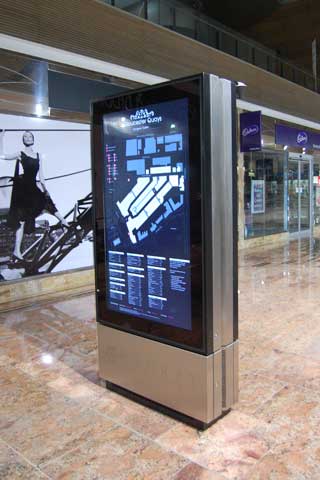 |
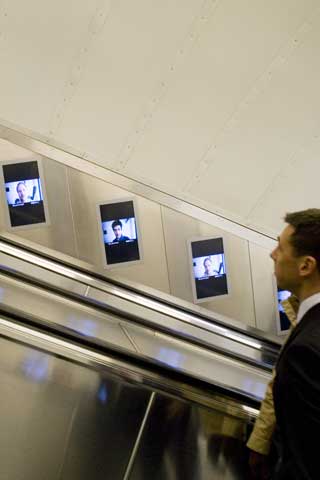 |
| LCD panel Street Bright Photo credit: Esprit Digital |
Escalator LCD panels in UK tube Photo credit: Esprit Digital |
With Street Bright Panels being only 60 mm in depth this is a formidable challenge. To stay ahead of the competition the company came up with the “green advertising” solution that helps to save 40% of energy by using solar panels and ambient light sensors that adapt LCD panel brightness to actual street brightness levels. This new product by Esprit Digital shows the right measure of ingenuity and creativity in search of solutions for outdoor advertising screens operated in tough outdoor conditions.
Outdoor LED screens by Daktronics
Founded in 1968, the company Daktronics went a long way to become an indisputable leader and the largest manufacturer of Digital Out-of-Home LED screens. The presentation gave a brief outline of company’s current products and projects and touched upon future developments in the area. The wide range of Daktronics products includes LED screens with as tight pitch as 3 mm and as wide as 89 mm.
However, the outdoor applications traditionally start at 10 mm, with 16 mm and 20 mm being the most popular and economical. Some projects quoted during the presentation include:
- McDonalds 16 mm LED screen in Piccadilly Square (London);
- a 20 LED screens network for JCDecaux (in London) based on economical return-on-investment 20 mm solution;
- the largest LED screens in the Times Square (New York) with different pixel pitches from 16 to 32 mm;
- a well-known Crushed Coke Can LED screen built with concave and convex 16 mm LED modules;
- as well as a recent Bucharest cascade of 20 mm LED screens.
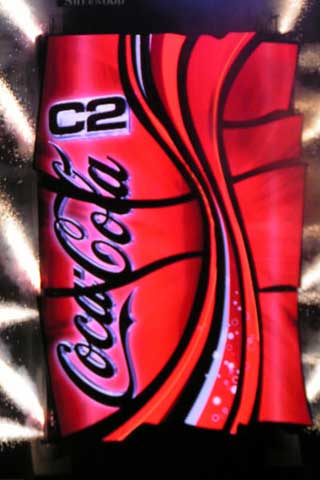 |
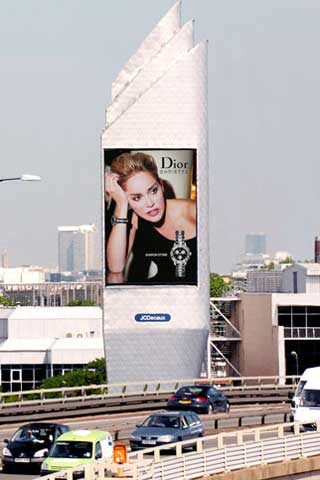 |
| LED screen Coca-Cola, Times Square, New York, USA Photo credit: Daktronics |
LED screen JCDecaux, The Torch, London, UK Photo credit: Daktronics |
However, it was not the projects that the presentation was focusing on but the essential message that Daktronics is all about turn-key solutions. With in-house capabilities for design, manufacturing, installation and servicing, the company offers its clients a free consultancy service at the earliest stages of the project. A competent project management from design stage to guarantee service is probably the main tool for beating the tough competition in a well developed LED screen market of today. However “the trick is not putting a LED screen in, but looking after it”.
LCD panels by Samsung Electronics, UK
For a Korean company Samsung, vision statement is supposed to be #1 motivation. The Vision for Samsung Electronics UK is “Everyone in the UK sees a Samsung LCD panel at least once a day”. With this vision come serious sales quotas and Samsung seems to be doing well in spite of the constantly dropping prices on LCD panels. The reason for staying abreast of completion is addressing challenges and finding proper and timely solutions.
As all other companies Samsung sees a lot of potentially good projects going nowhere. The main reason seems to be a problem with the return-on-investment (ROI). This made the company develop its own sophisticated software for audience measurement with the aim to demonstrate ROI to clients. Special pattern recognition software determines the potential audience, identifies gender and demographic age groups. Compared against outlet receipts such data allows to target the audience better and work with branding more effectively.
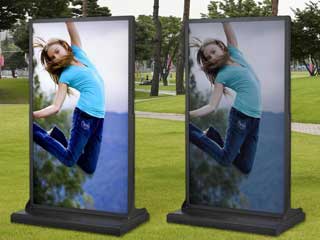 |
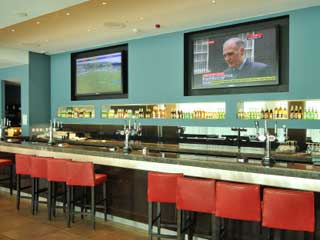 |
| Samsung's new 2000 nit LCD panel - on the left Photo credit: Samsung |
Samsung's LCD panels installed in Marriott Hotel Photo credit: www.dailydooh.com |
However this cannot solve all the problems, among which Samsung sees the following:
- Adaptation of content: created for TV audience, commercials do not always suit the digital OOH conditions. While at home we watch commercials in a relaxed atmosphere, in the street a digital image must grab our attention, thus it must be created differently;
- Some projects do not materialize because of restrictions on advertising to special requirements to advertising media. The answer here is an interaction with local authorities at the earliest stages of project planning;
- Availability of proper services that help to avoid obvious problems with heat dissipation (and LCD panel stoppages) and reliable delivery of content;
- Timely on-site maintenance called to replace such standard items as fans and filters.
With digital OOH revenues expected to nearly triple in Western Europe by 2012 in spite of the financial crisis, Samsung UK search for new ways of bringing advertising to the audience. And here the Street Pole Models recently developed in Korea (one such test installation completed at Convention Center in London) could be really useful. The pole is made of two sections, lower section been an LCD panel targeting pedestrians, while the top portion of the pole is a LED screen that targets traffic flow.
In conclusion of his presentation Director of Samsung UK Mr. Dominic Web expressed the need for OOH networks to start growing. The market for digital OOH advertising grows fast but large networks of 600-1000 LCD panels are still only being planned. Time has come for large digital OOH networks to come in existence.





